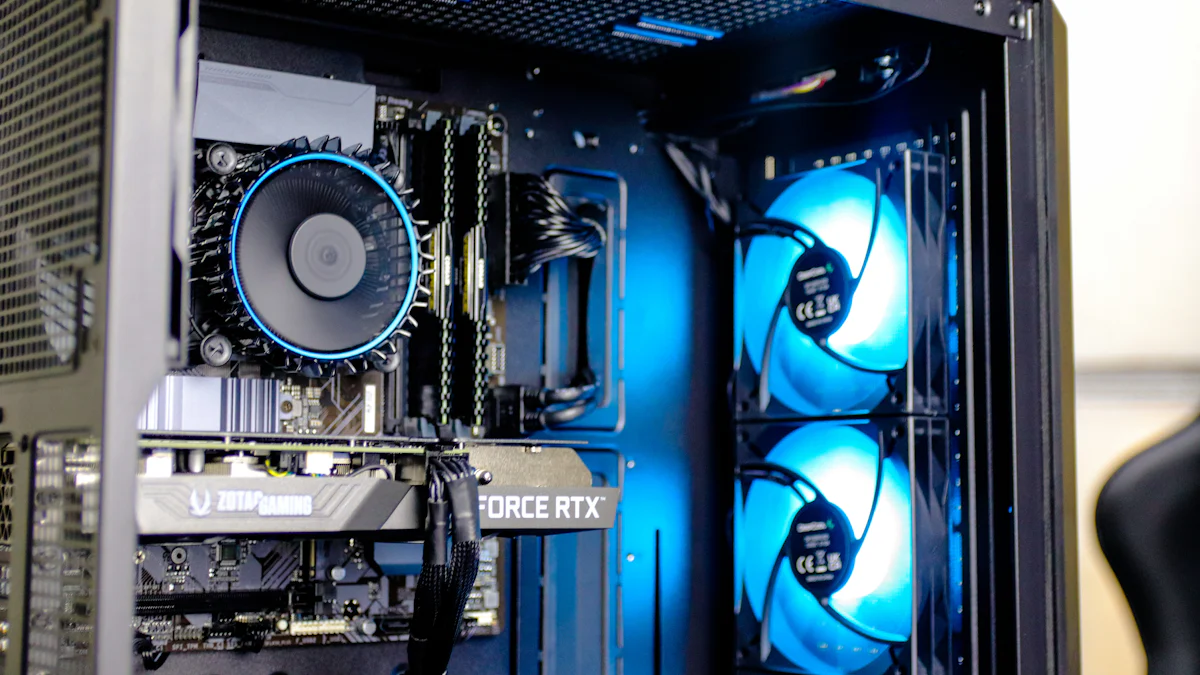How to Maximize Efficiency with PowerHobby Cooling Fans

Cooling fans play a crucial role in hobbyist applications. Whether you're into RC cars or drones, keeping your equipment cool ensures optimal performance. The power-hobby cooling fan stands out with its efficiency and reliability. It helps prevent overheating, which can lead to costly damage. This blog will guide you on how to maximize efficiency with these fans, ensuring your hobby gear runs smoothly and lasts longer.
Understanding the Role of Cooling Fans
Cooling fans are essential in keeping your hobby gear running smoothly. Let's dive into why they're so important and how they can enhance your experience.
Why Cooling is Essential
Preventing Overheating
You know how frustrating it is when your RC car or drone suddenly stops working. Overheating is often the culprit. A power-hobby cooling fan helps keep temperatures in check. It prevents your equipment from getting too hot, which can cause damage. By using these fans, you protect your investment and ensure longer-lasting performance.
Enhancing Performance
When your gear stays cool, it performs better. A power-hobby cooling fan boosts efficiency by maintaining optimal temperatures. This means your RC car races faster, and your drone flies smoother. You get the most out of your hobby, enjoying every moment without worrying about overheating issues.
Applications of PowerHobby Cooling Fans
RC Cars
RC cars generate a lot of heat, especially during intense races. A power-hobby cooling fan is perfect for keeping your car's motor cool. It ensures that your car runs at peak performance, letting you focus on winning the race. You’ll notice improved speed and reliability with the right cooling setup.
Drones
Drones require precision and stability. Overheating can disrupt their performance. By installing a power-hobby cooling fan, you maintain the drone's balance and responsiveness. This fan keeps the motors cool, allowing for longer flight times and better control. You can explore the skies without interruptions.
Selecting the Right PowerHobby Cooling Fan
Choosing the right power-hobby cooling fan can make a big difference in your hobby experience. You want to ensure that your equipment stays cool and performs at its best. Let's explore what you need to consider when selecting the perfect fan.
Factors to Consider
Size and Compatibility
First, think about the size of the power-hobby cooling fan. It needs to fit your equipment perfectly. Measure the space where you plan to install the fan. Make sure it matches the fan's dimensions. Compatibility is key. You don't want a fan that's too big or too small. Check the specifications of your RC car or drone to find the right match.
Power Requirements
Next, consider the power requirements. Different fans need different voltages. Some power-hobby cooling fans operate at 5-6 volts, while high-speed models might need 7.4-8.4 volts. Ensure your power source can handle the fan's needs. This ensures optimal performance and prevents any power issues.
Comparing Different Models
Features and Specifications
When comparing models, look at the features and specifications. Some power-hobby cooling fans come with advanced features like adjustable speeds or built-in temperature sensors. These can enhance your cooling setup. Review the specs carefully. Understand what each model offers and how it fits your needs.
User Reviews and Ratings
Finally, check user reviews and ratings. Other hobbyists' experiences can provide valuable insights. Look for feedback on performance, durability, and ease of installation. A power-hobby cooling fan with positive reviews is likely a reliable choice. Trust the community's opinions to guide your decision.
Installation Tips for PowerHobby Cooling Fans
Installing a power-hobby cooling fan can seem daunting, but with the right approach, you can do it easily. This section will guide you through the process, ensuring your fan works efficiently and effectively.
Preparing for Installation
Before you start, preparation is key. You want to make sure you have everything you need and that you're ready to install your power-hobby cooling fan safely.
Gathering Necessary Tools
First, gather all the tools you'll need. A screwdriver, pliers, and some electrical tape should be on your list. You might also need a small wrench, depending on your setup. Having these tools ready will make the installation process smoother and quicker.
Safety Precautions
Safety should always come first. Make sure your equipment is turned off and unplugged before you begin. This prevents any accidental shocks or damage. Wear safety goggles if you're working in a tight space or if there's a risk of debris. Taking these precautions ensures a safe installation process.
Step-by-Step Installation Guide
Now that you're prepared, let's dive into the installation process. Follow these steps to install your power-hobby cooling fan correctly.
Mounting the Fan
Position the Fan: Place the power-hobby cooling fan where it will get the best airflow. Typically, this is near the motor or heatsink.
Secure the Fan: Use screws to mount the fan securely. Make sure it's tight enough to stay in place but not so tight that it damages the fan or the equipment.
Check Alignment: Ensure the fan blades are not obstructed. They should spin freely without hitting any other parts.
Connecting the Wiring
Identify the Wires: Locate the power wires on your fan. Usually, there's a red wire for positive and a black wire for negative.
Connect to Power Source: Attach the wires to your power source. For maximum efficiency, connect the fan directly to the battery. This ensures the fan gets enough power to operate effectively.
Secure the Connections: Use electrical tape to secure the connections. This prevents them from coming loose during operation.
Test the Fan: Turn on your equipment and check if the fan spins properly. Listen for any unusual noises that might indicate a problem.
By following these steps, you ensure your power-hobby cooling fan is installed correctly and ready to keep your equipment cool. Proper installation maximizes the fan's efficiency, helping your hobby gear perform at its best.
Maintenance Practices for Optimal Performance
Keeping your PowerHobby cooling fans in top shape ensures they work efficiently. Regular maintenance helps you avoid unexpected issues and prolongs the life of your equipment. Let’s explore some essential practices.
Regular Cleaning
Dust and debris can hinder your fan's performance. Regular cleaning keeps everything running smoothly.
Removing Dust and Debris
Turn Off Equipment: Always switch off your gear before cleaning.
Use a Soft Brush: Gently brush away dust from the fan blades and surrounding areas.
Compressed Air: Blow out any stubborn particles with a can of compressed air.
By keeping your fan clean, you ensure optimal airflow and cooling efficiency.
Checking for Wear and Tear
Inspect your fan regularly for signs of wear.
Look for Cracks: Examine the fan blades for any cracks or damage.
Check Connections: Ensure all wires and connections remain secure.
Spotting issues early helps you address them before they become major problems.
Performance Checks
Regular performance checks keep your fan functioning at its best.
Monitoring Temperature Levels
Keep an eye on your equipment’s temperature.
Use a Thermometer: Monitor the temperature around your fan and motor.
Set Alerts: Consider using a temperature sensor to alert you if things get too hot.
Maintaining the right temperature ensures your gear performs optimally.
Ensuring Proper Functionality
Make sure your fan operates correctly.
Listen for Noises: Unusual sounds might indicate a problem.
Test Regularly: Turn on your equipment and check the fan’s operation.
Regular checks help you catch issues early, ensuring your fan continues to cool effectively.
Troubleshooting Common Issues
Even with the best setup, you might encounter some hiccups with your PowerHobby cooling fans. Don't worry! Let's tackle these common issues together and get your fan back in top shape.
Identifying Problems
Before diving into solutions, you need to pinpoint what's going wrong. Here are two frequent problems you might face:
Fan Not Spinning
You turn on your equipment, but the fan stays still. This can be frustrating, especially when you need that cooling power. Check if the fan is getting power. Look at the wiring connections. A loose wire might be the culprit. Also, inspect the fan blades. Sometimes debris can block them from spinning.
Unusual Noises
Your fan makes strange sounds. This can be a sign of trouble. Listen carefully. Is it a rattling noise? Maybe something is loose. A grinding sound might mean the fan blades are hitting something. Identifying the noise helps you figure out the next steps.
Solutions and Fixes
Once you've identified the problem, it's time to fix it. Here are some solutions to get your fan running smoothly again:
Replacing Faulty Parts
Sometimes parts wear out or break. If your fan isn't spinning, a faulty motor might be the issue. Consider replacing it. For unusual noises, check the fan blades. If they're damaged, swap them out for new ones. Replacing parts can breathe new life into your fan.
Adjusting Installation
Improper installation can cause problems. If your fan isn't spinning, check the alignment. Make sure the fan is mounted correctly. Adjust the screws if needed. For unusual noises, ensure nothing obstructs the fan blades. A small adjustment can make a big difference.
By following these troubleshooting tips, you can keep your PowerHobby cooling fan in top condition. Addressing issues promptly ensures your equipment stays cool and performs at its best.
Enhancing Efficiency with Additional Accessories
Boosting the efficiency of your PowerHobby cooling fans can make a big difference in performance. By adding a few accessories, you can take your cooling setup to the next level. Let's explore how heat sinks and temperature sensors can enhance your fan's capabilities.
Using Heat Sinks
Heat sinks are a fantastic addition to your cooling system. They work hand-in-hand with your fans to keep temperatures down.
Benefits of Heat Sinks
Heat sinks absorb and dissipate heat away from your equipment. This helps maintain a stable temperature, preventing overheating. With a heat sink, your fan doesn't have to work as hard, which can extend its lifespan. You’ll notice improved performance and reliability in your hobby gear.
Installation Tips
Installing a heat sink is straightforward. Follow these steps for optimal results:
Choose the Right Size: Ensure the heat sink fits your equipment. Measure the area where you plan to install it.
Clean the Surface: Before installation, clean the surface of your motor or component. Remove any dust or debris to ensure a good fit.
Apply Thermal Paste: Use thermal paste to improve heat transfer between the heat sink and your equipment. Apply a thin layer for the best results.
Secure the Heat Sink: Attach the heat sink firmly. Use screws or clips to hold it in place. Make sure it’s secure but not too tight.
By following these tips, you can maximize the effectiveness of your heat sink, keeping your equipment cool and efficient.
Incorporating Temperature Sensors
Temperature sensors are a smart addition to your cooling setup. They provide real-time data, helping you monitor your equipment's temperature.
Monitoring and Alerts
With a temperature sensor, you can keep an eye on your gear's temperature. These sensors alert you if things get too hot, allowing you to take action before any damage occurs. You can set up alerts on your phone or computer, so you're always in the loop.
Integration with Cooling Fans
Integrating temperature sensors with your cooling fans is easy. Here's how you can do it:
Select a Compatible Sensor: Choose a sensor that works with your fan and equipment. Check the specifications to ensure compatibility.
Install the Sensor: Place the sensor near the area you want to monitor. Secure it with adhesive or screws.
Connect to Your System: Link the sensor to your cooling system. Some sensors can connect directly to your fan, adjusting its speed based on temperature readings.
Test the Setup: Turn on your equipment and check the sensor's readings. Make sure it accurately reflects the temperature.
By incorporating temperature sensors, you can enhance your cooling system's efficiency. You'll have peace of mind knowing your equipment is protected from overheating.
Adding these accessories to your PowerHobby cooling fans can significantly boost their performance. With heat sinks and temperature sensors, you ensure your hobby gear stays cool and runs smoothly.
Future Trends in Cooling Technology
Cooling technology is evolving rapidly, and you can expect some exciting changes on the horizon. Let's explore the future trends that will shape how you keep your hobby gear cool and efficient.
Innovations in Fan Design
The design of cooling fans is undergoing significant transformations. These innovations aim to enhance performance and sustainability.
Smart Cooling Solutions
Imagine a fan that adjusts its speed based on the temperature of your equipment. Smart cooling solutions are making this a reality. These fans use sensors to monitor heat levels and automatically optimize their operation. You won't have to worry about manually adjusting settings. The fan does it for you, ensuring your gear stays at the perfect temperature.
Eco-Friendly Materials
Sustainability is becoming a priority in fan design. Manufacturers are now using eco-friendly materials to create cooling fans. These materials reduce environmental impact without compromising performance. By choosing fans made from sustainable resources, you contribute to a healthier planet while keeping your equipment cool.
Impact on Hobbyist Applications
These innovations in cooling technology have a direct impact on your hobbyist activities. Let's see how they can enhance your experience.
Improved Performance
With smart cooling solutions, your equipment performs better. The fan's ability to adjust its speed ensures optimal cooling at all times. This means your RC car races faster, and your drone flies longer. You get the most out of your hobby, enjoying every moment without overheating concerns.
Sustainability Considerations
Eco-friendly materials in fan design align with sustainability goals. By using these fans, you support environmentally responsible practices. This not only benefits the planet but also reflects positively on your hobby. You become part of a community that values sustainability and innovation.
Incorporating these future trends into your cooling setup can elevate your hobby experience. Embrace the advancements in fan design and enjoy improved performance while contributing to a sustainable future.
You've learned how PowerHobby cooling fans can boost your hobby gear's performance. Remember these key points: choose the right fan, install it properly, and maintain it regularly. Implement these tips to keep your equipment running smoothly. Proper cooling is crucial. It prevents overheating and extends the life of your gear. By following these guidelines, you ensure your RC cars and drones perform at their best. Keep your hobby enjoyable and efficient with the right cooling solutions.
Brand Introduction: X-HON Fans
At X-HON Fans, we are a seasoned manufacturer with a focus on the production of cooling fans. Our products are widely recognized and utilized in a variety of industries, including lighting, wine cabinets, automotive cooling systems, welding machinery, and beyond. We specialize in the manufacturing of DC brushless fans, AC fans, dustproof guards, compact cooling fans, and industrial fans. We have achieved ISO9001 international quality system certification, and our products have been endorsed by certifications such as ROHS, TUV CE, FCC, SGS, and UL test reports. Our fans are integral to the operations of computers, communication devices, consumer electronics, automotive electronics, HVAC systems, and building automation.
We are committed to the production of high-performance cooling fans, providing both standard and tailored solutions to meet the specific needs of our clients. We offer sample testing to ensure that our products meet the highest standards of quality and reliability. Additionally, we are now pleased to provide IP68-rated waterproof fans across our entire product line, catering to the efficient and stable cooling requirements in complex environments.
See Also
Maximizing Cooling Efficiency Using X-HON Axial Fans
Analyzing PowerHobby Cooling Fans: Model Comparison
Effective Cooling Fan Solutions for Personal Computers
About US
X-HON
X- HON is a leading manufacturer of cooling fans,speciaizing in research, development, and production forover a decade. With a focus on quaity and inovation, we ofer arange of cooling solutions to global markets, ensuring superior performance and reliable service.
Address
Address1: HuaYuan Building, Xixiang Avenue, Bao'anDistrict, Shenzhen, Guangdong Province, china;
Address2: DaLingShan District, DongGuan,Guangdong Province, china
Contacts
frelin.jiang@x-hon.com
bella.cai@x-hon.com
+86 15626528321
To inquire about product specifications or to request custom fan designs,
please leave your email address.
Our dedicated service team will be in contact with you shortly.


